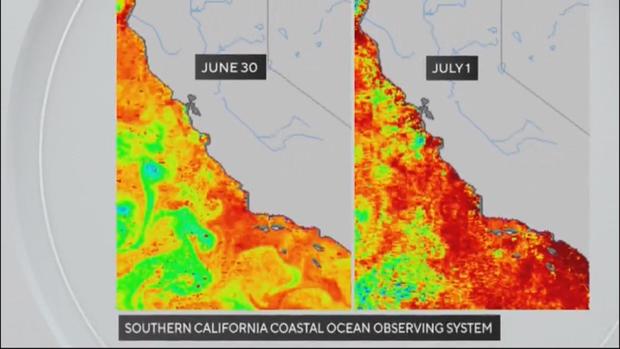Public Health urges against eating shellfish amid toxic algae bloom affecting sea life
Health officials are urging residents to stay away from certain shellfish as a toxic algae bloom has contaminated the waters off the Southern California coast.
"The public should take precautions to stay safe as California and Los Angeles County experience a bloom of toxic algae that is impacting marine life," said Dr. Barbara Ferrer, L.A. County Public Health Director.
According to health officials, the bloom contains a neurotoxin called domoic acid. At first, it only affected plankton feasting on the algae. However, it moved up the food chain as animals such as sea lions and dolphins began to eat contaminated fish like sardines.
So far, more than 100 sea lions have stranded themselves on beaches in L.A. County and others have attacked people in Orange County.
"Although you may want to help, the best and safest way to assist is to stay away and report the sick animal immediately," said Marcia Mayeda, director of L.A. County's animal control.
The concentration of the neurotoxin is expected to grow in size this weekend. Construction crews in Laguna Beach worked throughout the day on Friday to craft more pens for the sick marine animals that may wash up on local shores.
"The bloom is expected to get a little bit larger over this weekend, so we're anticipating to not just continue to get the same numbers of animals in but potentially even more over the next several days," said Dr. Alissa Deming, a veterinarian.
June is typically a slow month but the severe ocean conditions have increased the patient count at the facility by 95% compared to a year ago. This dramatic spike has prompted Orange County officials to consider housing the sick animals at a local school or on a public beach.
"We want to make sure that we keep the guests at the beach away from the animals. That's a top priority," said Supervisor Katrina Foley.
In large quantities, domoic acid can cause seizures, heart failure and even be fatal for humans. While sardines have made the sea lions recovering on local beaches sick, shellfish pose the greatest risk to humans, according to public health officials. Because of this danger, the California Department of Public Health urges residents stay away from "sport-harvested mussels, clams, or scallops from Santa Barbara County."
"Eating contaminated seafood can cause illness or even death in humans, and I urge residents to stay informed and check for state-issued shellfish advisories before consuming seafood and shellfish, such as crabs, clams, mussels and oysters," said Ferrer.
The symptoms of domoic acid poisoning may appear 30 minutes to 24 hours after eating toxic seafood. According to CDPH, mild cases can bring symptoms such as vomiting, diarrhea, abdominal cramps, headaches and dizziness. These will disappear within several days.
Also known as amnesic shellfish poisoning, severe cases of this sickness can cause patients to have trouble breathing, confusion, disorientation, cardiovascular instability, seizures, excessive bronchial secretions, permanent loss of short-term memory, coma or death. If you experience any of these severe symptoms, you should call 911 or immediately go to a doctor.




